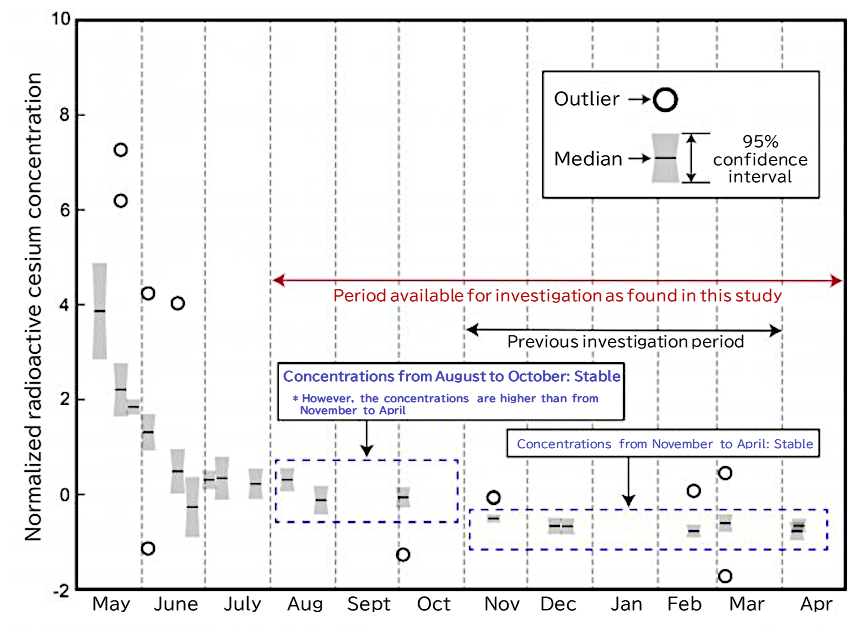Radioactivity Dynamics in forests
(2023)
QDo radioactive cesium concentrations in trees change season to season?
AThe Forestry and Forest Products Research Institute studied konara oak sapling forests from which mushroom logs are taken, and found that radioactive cesium concentrations in new konara oak branches (less than 1 year old) significantly change until July after sprouting leaves, and stabilize from August to the following April. This finding is expected to significantly expand the investigation period for determining usable mushroom log forests, and further promote the related business.
In Fukushima prefecture, people used to widely grow mushroom log trees such as konara oak especially in the Abukuma region. However, radioactive cesium released by the accident at the Fukushima Daiichi NPS that occurred in March 2011 contaminated the log tree forests. The contamination still lingers even after more than 10 years after the nuclear accident. The threshold radioactive cesium concentration in the trunk of konara oak trees usable as mushroom logs is 50 Bq/kg, and if there is an established method to easily check forests for tree trunks with radioactive cesium concentrations less than the threshold without felling them, that would be desirable. Amid such a situation, development of a technique to estimate radioactive cesium concentrations in the trunks of konara trees used as mushroom logs from radioactive cesium concentrations in their new branches (less than 1 year old; the same applies hereinafter) without felling them has been in progress, using a certain correlation between the two. However, sampling investigation of new branches of konara oak trees for the estimation is limited to the resting period where trees stop growing, generally from November to the following March, and that is slowing down the investigation.
From 2018 to 2020, a study was conducted on seasonal variations in radioactive cesium concentrations in new branches of konara oak trees in Miyakoji, Tamura, Fukushima, which used to be the chief producing area of mushroom logs. In the study, five konara oak trees were selected at each investigation site in a total of six konara oak sapling forests which were felled and regenerated after the nuclear accident, new branches were continually collected from the same individuals, and their radioactive cesium concentrations were analyzed to check the seasonal stability. As a result, it was found that radioactive cesium concentrations in new branches of konara oak trees were stable without any statistical difference during the resting period from November to April (Figure 1). It was also found that radioactive cesium concentrations in new branches collected in the period from August to October were stable, albeit slightly higher than concentrations during the period from November to April, and the concentrations could be converted to the November-April levels by applying a coefficient (0.75±0.10). These results suggest that radioactive cesium concentrations are stable not only from November to March, the previously believed stable period, but also from August to October and in April, extending the sampling period available for the measurement of radioactive cesium concentrations in trunks that are to be used as mushroom logs.

Figure 1 New konara oak branch radioactive cesium concentration1), seasonal variation2)
The starting time of the horizonal axis is early May, where konara oak trees start leafing in Miyakoji, Tamura, Fukushima. The normalized radioactive cesium concentration in the vertical axis was derived by setting the average radioactive cesium concentration for the monitoring period to zero, and dividing the fluctuations by the standard deviation. This method enables comparing radioactive cesium concentrations in various sizes of new konara oak branches collected from 2018 to 2020 at multiple investigation sites in one chart. As shown in the legend, the solid line at the middle of shaded area indicates the median, and the shaded area indicates the 95% confident interval of the median. When the shaded areas are compared across the number of days elapsed from May 1, if the numbers are similar to what is enclosed in blue broken lines, it means the medians have no statistical difference.
- All measurement results are normalized to the concentration at June 1, 2018 based on the half-life, in order to eliminate the effect of natural reduction in radioactive cesium concentrations during the monitoring period due to radioactive decay.
Also, the concentrations are shown without distinguishing the year of sampling (2018, 2019, or 2020). - In areas whose climate (e.g., temperature) is different from Miyakoji, Tamura, the period available for investigation may be different from the period shown in the figure.
This study scientifically showed that the investigation period for new branches could be extended from the previous 5 months (from November to March) to 9 months (August to April) for the first time in the world, and provided a finding that is important in developing and implementing a technique to estimate radioactive cesium concentrations in konara oak trunks from their new branches. Research and development of techniques and technologies for determining usable konara oak trees will be continued in the future.
(Research results from the Forestry and Forest Products Research Institute and others. Reproduced from the website of the Forestry and Forest Products Research Institute (partly edited by JAEA))
Related articles
- I heard most of the forests would not be decontaminated. Does cesium remain in the forests?
- How does radioactive cesium in forests move from trees to the ground surface? 【Movement in throughfall, stemflow, and litterfall】
- How does radioactive cesium in forests move from trees to the ground surface? 【Movement as particulate and dissolved states】
